The Complete Guide to SEO for Ecommerce (2026 Edition)
Oct 22, 2025
Written by Casey Bjorkdahl

Casey Bjorkdahl is one of the pioneering thought leaders in the SEO community. In 2010, Casey co-founded Vazoola after working for a Digital Marketing Agency for five years in New York City. Vazoola is now one of the fastest growing and most widely recognized SEO marketing firms in the country.
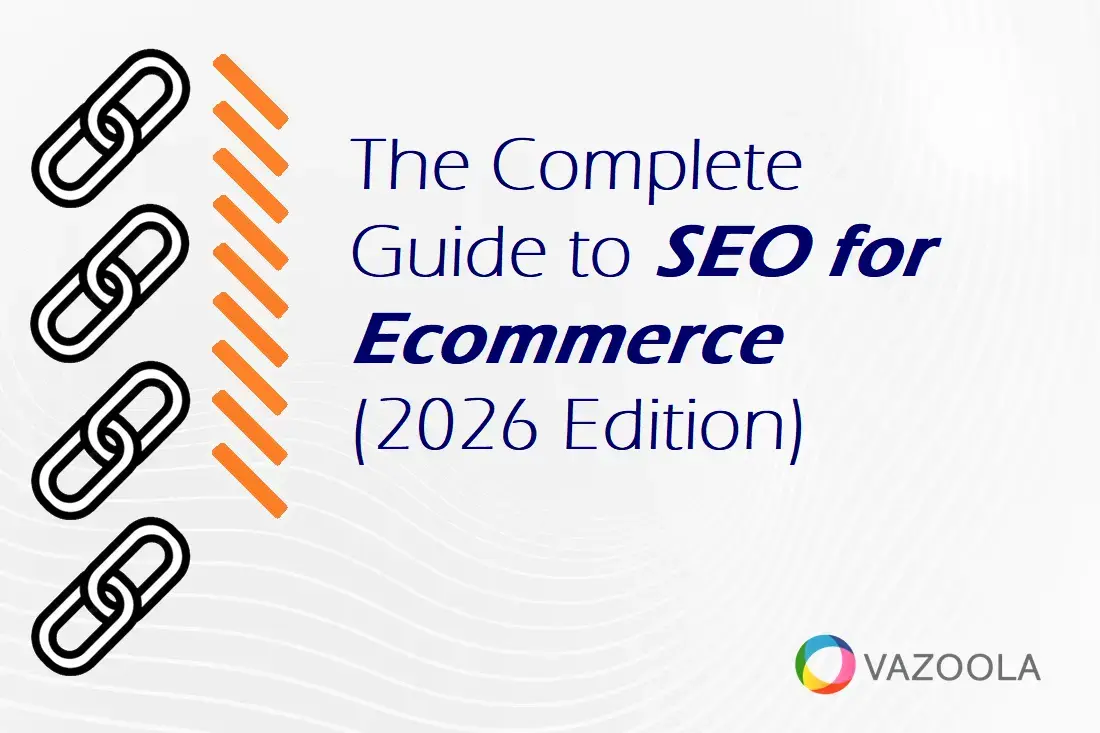
SEO in Ecommerce Means Turning Clicks Into Conversions
In today's high-speed online marketplace, having a great product is no longer good enough. Since 37.5% of all online purchases start with an organic search, there is no question you need a solid SEO strategy for ecommerce in order to compete.
With the explosion of e-commerce, after all, the competition is fiercer than it has ever been; a digital storefront is no longer enough to set any business apart.
The secret sauce? SEO for ecommerce. Whether you’re a marketing veteran, a content creator re-launching an online store, or a business owner looking to increase sales, the right SEO strategies can turn clicks into conversions.
Are you interested in all the key SEO tactics that can boost the visibility of the website, increase engagement, and improve sales? To turn your e-commerce website into a shopper magnet, we’ve compiled some of the best SEO strategies you can make use of for an e-commerce website.
Why SEO Matters for Online Stores
What is SEO for ecommerce?
SEO for ecommerce means optimizing an online store so its product and category pages rank higher in search engines, driving more visibility, traffic, and sales. Simply put, it means making your online store easier to find on Google (and other search engines) so more shoppers discover your products and buy from you.
SEO for e-commerce has become one of the most important ways to get noticed in the swarm of digital stores. It brings visibility to your website when done right, boosting conversion rates.
From product page SEO to outranking huge marketplaces like Amazon and Walmart, ecommerce businesses have to take care of unique challenges related to SEO. For an ecommerce store to be successful, site structure, content, and off-page strategies need to be optimized with search engines, while user needs are also taken into consideration.
In fact, according to a Search Engine Journal study, Google’s algorithm increasingly favors ecommerce sites with user-generated content, so many businesses are rethinking their approach to SEO.
Ecommerce SEO vs traditional SEO
Are there special SEO strategies for ecommerce? Ecommerce SEO is different because it’s all about helping your products and categories show up in Google, while regular SEO usually focuses on blogs, services, or local businesses.
SEO for ecommerce is different because online stores face unique challenges that most other websites don’t:
-
Lots of product pages: Instead of a few service pages or blog posts, ecommerce sites often have hundreds (or thousands) of products to optimize.
-
Category pages: These need their own SEO strategy since they target broader keywords and drive shoppers to groups of products.
-
Duplicate content issues: Similar or repeating product descriptions, filters, and faceted navigation can confuse search engines.
-
User-generated content & reviews: Reviews, Q&A, and ratings play a much bigger role in ecommerce SEO than in other industries.
-
Competition with marketplaces: Stores have to compete with giants like Amazon, Walmart, and eBay in search results.
In short, ecommerce SEO is about helping individual products and categories get found, while non-ecommerce SEO usually focuses more on services, blog content, or lead generation.
7 Ecommerce Google Search Hotspots: The ‘Product Grids’
Search engine results pages have transformed over the years, especially in ecommerce. Google’s layout for shopping queries now resembles an Amazon-like experience. It offers multiple entry points for consumers. Each section brings unique opportunities for ecommerce sites to gain visibility.
Google has plenty of guidance for ecommerce webmasters seeking higher rankings. The Google Merchant Center features an online knowledge base that explains how Google for ecommerce works, as well as how to get started.
It’s important to reiterate a recent change in Google’s search ranking results. Google is elevating more ecommerce websites and those featuring user-generated content as it reduces the visibility of product review and affiliate marketing sites. That gives ecommerce sites a chance to gain more visibility, traffic, and ultimately sales.
So, in exactly what ways does Google display ecommerce search results? They appear in seven common product grids, so called because the images are laid out in a grid-like fashion.
-
Popular Products
Google highlights trending items based on searches, ratings, and reviews. Getting your best-sellers featured here increases visibility and helps shoppers compare top options across retailers. Solid reviews and competitive pricing improve your chances of appearing.
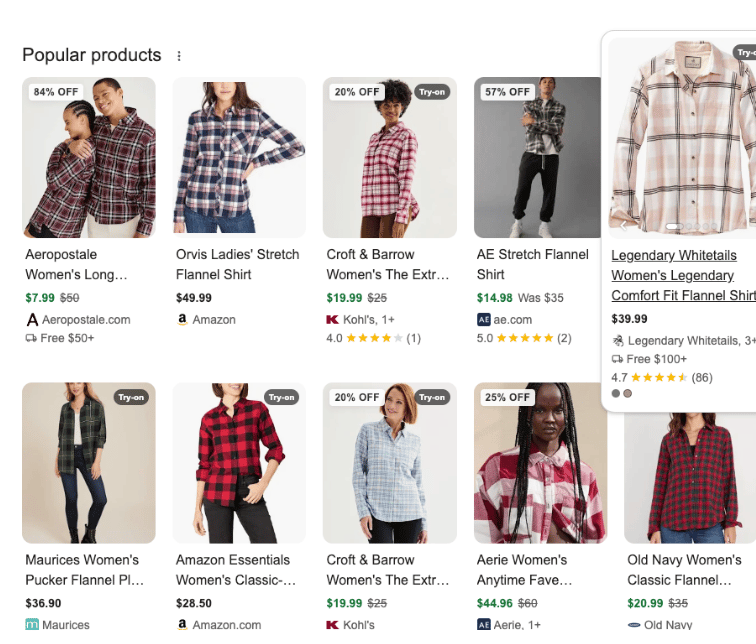
-
Google Shopping
Google Shopping showcases products with images, prices, and vendor info, pulled from Merchant Center feeds. Optimizing product data ensures your listings appear in these comparison grids, where shoppers often make quick purchase decisions.
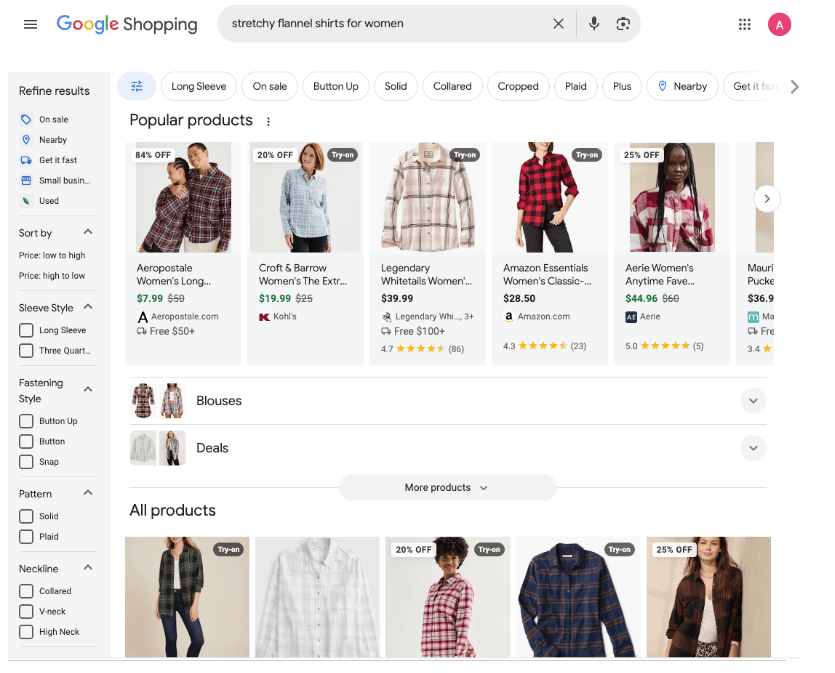
-
Organic Search
Organic listings appear based on relevance, not ads. Optimizing titles, descriptions, and images helps your products rank higher. Shoppers trust these results most, making them essential for long-term visibility.
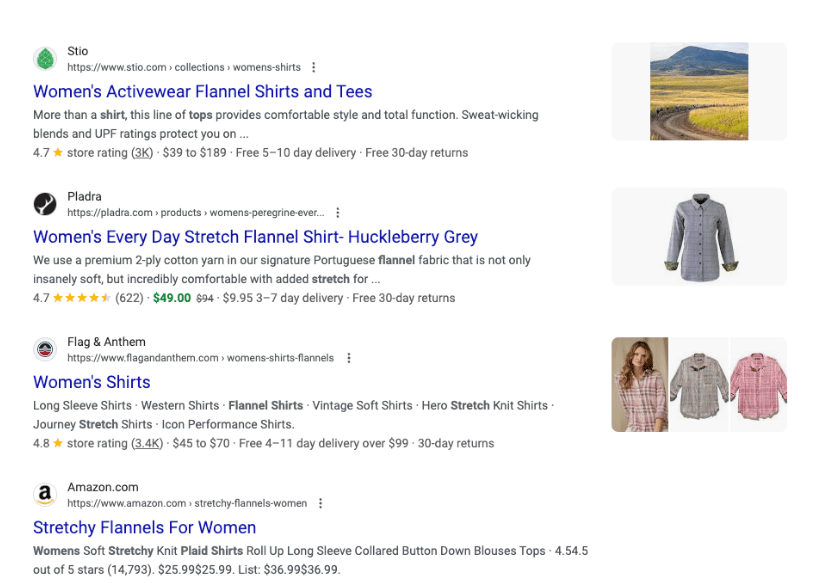
-
More Products
This section gives retailers a “second chance” to be seen when top results don’t meet shopper needs. Optimized product data and strong category pages help you appear here.
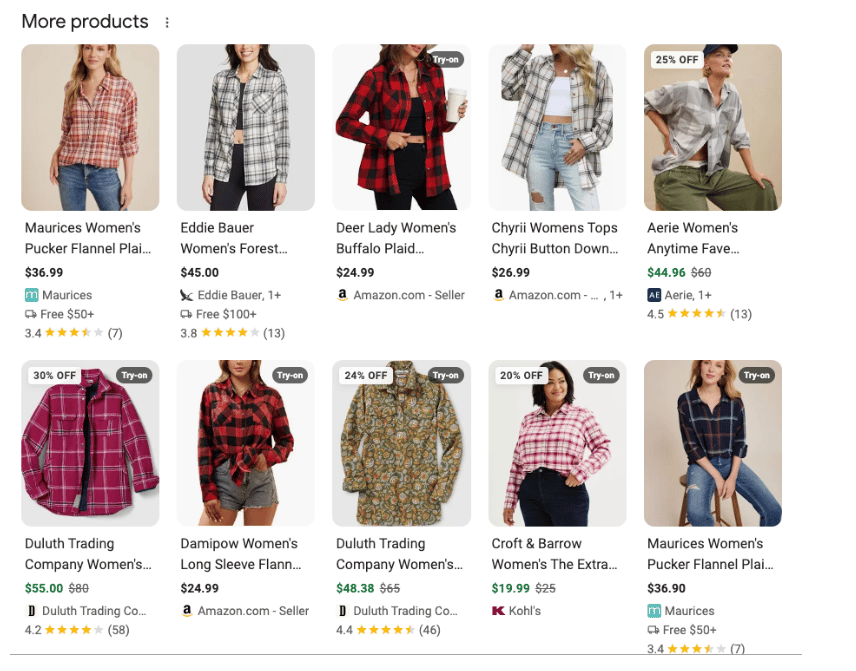
-
Deals
Google’s Deals section features discounts and promotions. Highlighting sales in your Merchant Center feed gets your products in front of bargain-hunters ready to purchase.
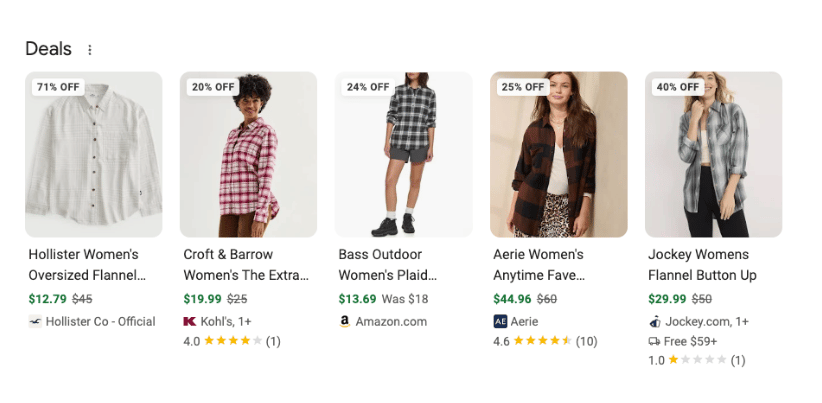
-
People Also Buy From
This section suggests trusted retailers shoppers turn to after a search. Building brand authority, consistent stock, and competitive pricing increases your chance of being featured.
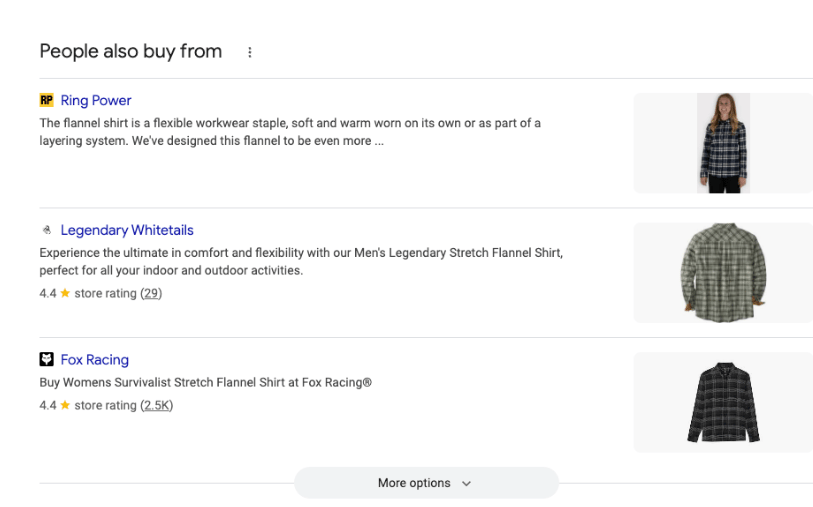
-
Fast Pickup or Delivery
Google highlights products available for same-day delivery or local pickup. Optimizing inventory feeds and offering fast fulfillment helps capture shoppers who need products quickly.
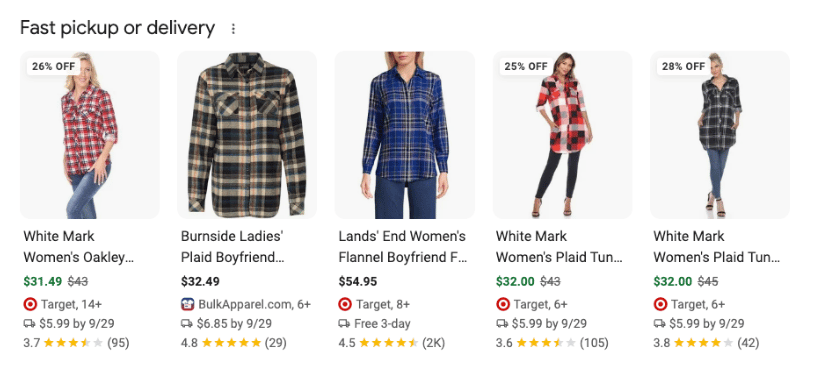
12 Tips for Ecommerce SEO
1. Keyword Research for Online Retailers
Finding buyer-intent keywords: Ecommerce keyword research is different from traditional SEO. Your keywords need to match buyer intent and align with your product line. The goal is to target terms that your ideal customers actually use, balance competition, and support your brand’s visibility. Even if you know your products well, keyword research reveals valuable opportunities you might miss. (Learn more in our [keyword research guide].)
Long-tail keywords for product discovery: For businesses with a diverse product range, long-tail keywords can drive more targeted traffic. According to Moz, long-tail searches account for 70% of all web searches, offering more specific, buyer-intent-driven opportunities for ecommerce stores.
For more hints on optimizing keywords, check out our top keyword research tips to keep in mind.
Why ecommerce keyword research matters: The right keywords connect your products with shoppers who are ready to buy, helping your store rank higher, attract targeted traffic, and drive more sales.
2. Optimize Your Ecommerce Site Structure
Organize products into a clear category hierarchy: Optimizing your ecommerce site structure is essential for improving both user experience and search engine rankings. A well-organized site allows visitors to easily navigate and find products while helping Google understand and index your pages.
Clear categories, intuitive navigation, and fast load times are key to a successful ecommerce site structure.
Men’s Clothing
- /mens/tops/t-shirts/
- /mens/tops/polo-shirts/
Women’s Clothing
- /womens/dresses/casual/
- /womens/dresses/evening/
Accessories
- /accessories/bags/handbags/
- /accessories/bags/backpacks/
Why this matters: A clear category hierarchy makes it easier for shoppers to quickly find what they need and helps Google understand your site’s structure, which improves both user experience and search rankings.
3. Set up your Google Merchant Center
Submitting a product feed to Google Merchant Center ensures your products are eligible to appear in Google Shopping and other product-rich results. An optimized feed with accurate titles, pricing, and availability gives your store more visibility in search and helps shoppers compare options directly in Google’s shopping grids.
Why Google Merchant Center matters: A properly managed feed increases your chances of being featured in high-visibility placements like Google Shopping, Deals, and Popular Products.
4. Use internal links to connect products and categories
Link related products, categories, and blog posts to each other: This keeps shoppers browsing longer, helps them discover more items, and signals to Google how your pages are connected. Automate internal linking between product pages and blog content using AI-powered tools to create a more interconnected site structure that boosts rankings and improves user navigation.
|
Tool |
Platform / Use Case |
What It Does |
|
LinkWhisper |
WordPress / WooCommerce |
Suggests internal links based on content context and can auto-insert links. (linkwhisper.com) |
|
SEO Clarity (Link Seeker / ClarityAutomate) |
Enterprise / large sites |
Uses AI/NLP to analyze pages, identify underlinked content, and implement internal links at scale. (seoClarity) |
|
LinkStorm |
CMS-agnostic (or works with many platforms) |
Crawls your site, finds internal link opportunities, and can auto-place links for you. (LinkStorm) |
|
AutoLinking.ai |
Blogs / CMS systems |
Uses semantic analysis to identify related pages and creates internal links between them. (autolinking.ai) |
|
TailorTask (Internal Linking Tool) |
General SEO tool suite |
Automates internal link suggestions and linking using AI for contextually relevant placement. (tailortask.ai) |
Why this matters: Internal links guide shoppers to related products and categories, keeping them engaged longer, while also helping Google crawl your site more effectively and understand which pages are most important.
5. Use descriptive URLs
Your URLs should be short, readable, and keyword-rich so both shoppers and search engines instantly understand what the page is about. Many ecommerce platforms default to using product IDs or SKUs in URLs, but these aren’t search-friendly.
For example:
SKU-based URL (not optimized): www.store.com/product/sku12345/
Descriptive, keyword-rich URL (optimized): www.store.com/mens/tops/t-shirts/black-cotton-crewneck/
SKU-based URL: www.store.com/item/4578gh90/
Optimized product URL: www.store.com/womens/dresses/evening/red-satin-gown/
Why descriptive URLs matter: Descriptive URLs improve click-through rates because shoppers know what to expect. Keywords in URLs help Google rank your product pages for relevant searches. Clean structures make your site easier to navigate and scale as you add products.
6. Implement breadcrumbs for easy site navigation
Breadcrumbs help crawlers and people explore your site: Breadcrumbs are a navigation trail that shows users (and Google) where a page sits in your site’s hierarchy — like Home > Women’s Clothing > Dresses > Evening Dresses. They improve crawlability by search engines and help shoppers navigate through your website, exploring options.
Why breadcrumbs matter: Breadcrumbs matter because they help shoppers navigate your store easily and show Google how your site is structured, improving both usability and SEO.
7. Optimize your product detail page (PDP) for search
A product detail page (PDP) is a dedicated page on an ecommerce website that provides all the information about a product, including photos, videos, specifications, pricing, and customer reviews.
On-page SEO is key to making your PDPs visible and engaging: Optimizing elements like meta titles, product descriptions, and image alt texts with targeted, descriptive keywords ensures that your pages rank higher in search results. Detailed, keyword-rich descriptions help users find exactly what they’re looking for while improving your site’s overall search visibility. Proper on-page optimization enhances user experience and drives more conversions.
Your product title, description, and images are the first things both shoppers and Google see. A clear, keyword-rich title (e.g., “Men’s Black Cotton Crewneck T-Shirt” instead of just “T-Shirt”) paired with a detailed description helps products rank and convert. Optimized images with descriptive alt text improve search visibility and user experience.
Why it matters: Clear, optimized content makes your products easier to find in search results and more compelling for shoppers to click and buy.
8. Use schema for product reviews, pricing & availability
Schema markup tells Google exactly what’s on your product page — like the price, stock status, and customer ratings. For example, a women’s dress page might show ⭐ 4.8/5, “$79.99,” and “In Stock” right in the search results.
Why it matters: Rich snippets help your product stand out in search, boosting click-through rates and building trust before a shopper even lands on your site.
9. Encourage user-generated content (UGC)
Reviews, photos, and Q&A from real customers add valuable content to your product pages. For instance, shoppers posting photos of how they styled a jacket creates fresh, authentic material that search engines love.
Why it matters: UGC builds trust, reduces hesitation to buy, and improves SEO since Google favors pages with dynamic, user-driven content.
10. Audit your online retail site for SEO
Technical SEO is vital for ecommerce success. It ensures your site is both user-friendly and optimized for search engines. But it's often an element that is overlooked. Regular SEO audits help identify common issues that can impact rankings and user experience. A few common technical SEO issues to be on the lookout for include:
-
Slow page load times lead to high bounce rates, which can kill an ecommerce store. Use Google PageSpeed Insights to help identify and fix problem pages.
-
Broken links harm SEO and frustrate users. Google Search Console can help detect broken links so you can fix them.
-
Duplicate content can confuse search engines, causing them to ignore your content, which can be especially troublesome for ecommerce sites that sell multiple, similar products.
-
Roughly 76% of U.S. adults use mobile devices to shop online, according to CapitalOne. Your ecommerce site must be mobile-friendly. How-to is beyond the scope of this post, so we recommend starting with Google Ads Help to make your ecommerce site mobile friendly.
Why SEO audits matter: The idea is to identify and fix technical issues before they cause significant problems. Additionally, your technical aspects need to be healthy in order for your other SEO strategies to be effective!
11. Ecommerce Link Building Strategies
For ecommerce businesses, a well-rounded backlink strategy not only drives traffic but also establishes trust with search engines. While the process of outreach and securing backlinks can be complex, leveraging the right ecommerce link building tactics can set your online store apart. High-quality backlinks from reputable sources tell search engines that your content is valuable, credible, and trustworthy – qualities that can significantly improve your site's visibility and organic search performance.
Want help with link building? Visit our link building service for e-commerce sites page.
Ecommerce link building strategy options include:
-
Product page broken link building: Identify broken links on external websites that could be pointing to your products or similar ones. Offer your product page as a replacement to the broken link.
-
Analyze your competitors’ backlinks to discover which sites are linking to them. You can then reach out to these sites with your own relevant content or products.
-
Target blogs and websites that compile “best of” lists or product roundups. For example, if your ecommerce site sells outdoor gear, reaching out to a site compiling the “Best Hiking Backpacks” and pitching your product could earn you a spot in their content along with a valuable backlink.
-
Leverage customer reviews. Encouraging customers to leave reviews on third-party sites or their own blogs is an organic way to build backlinks.
-
Take advantage of directory listings. Submit your site to high-quality business directories, especially those specific to your industry, to provide valuable backlinks. Directories such as Yelp, Trustpilot, or industry-specific listings help build authority and improve local SEO if your ecommerce business has a physical presence.
-
Create category and product page backlinks. Category page backlinks build broad visibility for groups of products (like “men’s running shoes”), while product page backlinks target individual items. A healthy mix strengthens both discovery and conversions.
-
Prioritize seasonal campaigns like Black Friday, back to school, and holiday promos: Seasonal backlinks boost visibility for time-sensitive landing pages. Optimizing for events like Black Friday helps to ensure your deals appear in search results when shoppers are most ready to buy.
-
Links offer a competitive edge in marketplaces. Even with Amazon pulling back from Google ads, which made them nearly disappear from organic marketplaces, big brands like Walmart and eBay still dominate. Building strong, niche-relevant backlinks helps independent stores secure visibility above or alongside these big players.
Why link building for ecommerce matters: Link building boosts the visibility and authority of your product and category pages, helping your store outrank competitors, attract ready-to-buy traffic, and capture more sales during both everyday searches and peak shopping seasons.
12. Local SEO for Retailers
Even if your ecommerce business operates primarily online, local SEO can still benefit you, especially if you have a physical location or offer local pickup options. Local SEO helps online stores get found by nearby shoppers, especially if you offer local pickup, same-day delivery, or have a physical location. Optimizing for local keywords, Google My Business, and customer reviews boosts visibility in “near me” searches and builds trust with buyers.
If you don’t have the time or skills to engage in successful local SEO, our experts can take your ecommerce local SEO to new heights.
13. Other Tactics for Ecommerce Optimization
Google Business Profile: One key element is building a strong Google Business Profile to boost visibility, especially if you have physical locations. This helps with local SEO and improves trust with potential customers.
Social Media: Maintaining an active social media presence likewise supports brand awareness and drives traffic. While social media links don’t directly impact SEO rankings, they help increase brand exposure and lead to natural backlinks from other sites. Engaging with your audience through platforms like Instagram, Facebook, and Pinterest can help showcase products, encourage user-generated content, and keep your brand top of mind. The strategy can result in increased traffic, higher engagement, and potentially more backlinks as others reference your site.
Content hubs and buyer guides: Create in-depth guides that group related products together (like a “Running Gear Hub”). These pages rank for broader keywords and funnel shoppers into specific categories or products.
Blog posts that drive traffic to product pages: Write posts like “Best Winter Jackets for 2025” that naturally link to your product pages. This builds authority while sending ready-to-buy visitors directly to your store.
The Power of SEO Ecommerce
Mastering SEO ecommerce is all about driving traffic, visibility, and ultimately converting those visitors into customers. But it can be a challenge – even with our ecommerce SEO tips.
From optimizing your site structure and on-page elements to building value with backlinks and engaging off-page, each step you take plays a crucial role in the success of your store. After all, in such competitive online competition, a well-rounded approach to SEO is more than a tool – it's a necessity.
With ecommerce continuing to grow, the businesses that stand out and thrive will be the ones investing in effective SEO. The question now remains, will your business be one of those?
Ready to take your SEO to a whole new level and drive conversions? Vazoola can help create a winning strategy for you. Contact us today to learn how we can take your ecommerce site to the next level. Our team will help you successfully implement SEO for ecommerce stores.

